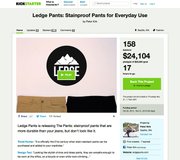FINANCE
'Crowdfunding': Fashion Finds New Revenue From the Multitudes
“Crowdfunding” is in fashion.
With traditional funding increasingly hard to get, many entrepreneurs are seeking to raise funds on crowdfunding platforms such as Kickstarter Inc., based in New York, and Indiegogo Inc., headquartered in San Francisco.
The crowdfunding platforms made a splash when they started more than four years ago as fundraising forums for film and music projects. But more fashion entrepreneurs have been trying their luck on them. The new funding avenue is intriguing even for veteran fashion-industry executives with successful track records such as Jeff Shafer, who sells his Agave brand at retailers such as Nordstrom. Earlier this year, he launched his new American-made denim line, Bluer, on Kickstarter.
Shafer thought crowdfunding would be the answer for fashion designers frustrated with traditional methods of funding.
“You have a great concept, [but] you don’t have an investor or an investment banker or a rich relative,” Shafer said of the situation that leads many to crowdsourcing platforms. “You get 97 percent of your money upfront, and it’s up to a handshake obligation to deliver when you say you will.”
But crowdfunding is no free ride. Many ventures are ignored and never receive a dime. If an entrepreneur does not deliver, the entrepreneur will be badmouthed online by all of the disappointed people who pledged money to the projects. It’s also a rule that entrepreneurs have to refund money donated to them.
Crowdsourcing platforms are a business. Kickstarter, for example, charges a 5 percent fee from a project’s total funding if the project proves successful. Because Kickstarter donations are processed by Amazon Payments, there is a 3 percent to 5 percent processing fee, according to the Kickstarter website. If a project is not successfully funded, Kickstarter does not collect its fees.
For new entrepreneurs Shuo Yang and Peter Kirk, Kickstarter represents more than a funding opportunity. It’s a chance to spread the word on their projects.
“I think the publicity and the interaction with customers is the key advantage,” Yang said. He started his Brooklyn, N.Y.–based line, ASPECD Apparel, this year.
There is a sense of drama and gamesmanship involved with the venture,” the Seattle-based Kirk said. His project is called Ledge. It is a chino bottom made with a technical fabric that Kirk says makes the pants more durable and stain-resistant than jeans.
Entrepreneurs have 30 days to fund. People from all over the world surf through the website to look for interesting ventures. Instead of stock, they receive product or some other incentive or reward. The guidelines prohibit project creators from simply selling preorders of finished product. Each project must include detailed progress reports on the state of the project’s development.
The benefits of a crowdsourcing campaign are not only monetary, Yang said.
“It’s an additional opportunity to do pre-sales and even get direct feedback on the products themselves in a way that engages with your customer,” Yang said.
The pledges and donations requested on crowdfunding platforms wouldn’t move most Wall Street players. Stars of Kickstarter include The 10-Year Hoodie, a New York–headquartered clothing line that received more than $1 million in funding in April. There’s also Gustin, a denim line that received $449,654 in funding in February. A statement on Gustin’s website announced that “the future of fashion will be crowdsourced” and that it will take its orders and funding only through crowdfunding.
Yang is looking for $10,000 to complete the first run of ASPECD Apparel. Kirk is looking for $24,000 to launch Ledge.
Shafer pre-sold more than $44,000 worth of Bluer goods on Kickstarter. The line will be made in America and is geared toward a demographic of college-age men and women 18 to 24.
Funding is tough for the vast majority of entrepreneurs, but it is even tougher for new businesses, said Frances Harder, founder of Fashion Business Incorporated, a Los Angeles–based nonprofit that provides the fashion industry with entrepreneurial education.
“Investors are looking for something already proven to sell,” she said. “They’re not looking for unknowns.”
Nick Hart, managing director of prominent factor Bibby Financial Services California, headquartered in Westlake Village, Calif., agreed. “We fund startups,” he said. “But they have to be at a point where they are making some sales.”
Hart did say that funding a project through a factor is relatively easy. “As long as you can show me receivables to other businesses and meet some simple criteria, we can lend you money.” Factors’ criteria are typically receivables to other businesses and no tax liens.
Hart considered crowdfunding competition for traditional factors, which typically make their money by funding a company’s receivables or product sales.
Bluer’s Shafer thought that crowdfunding can jumpstart innovation in the apparel business.” If you look at the number of new designers and businesses in the garment industry in the past five years, the number of new brands declined significantly. The cost of starting a new apparel brand is out of reach for most designers, and financing is harder than ever,” he said. But crowdsourcing offers a new avenue. “Crowdfunding is successfully starting new ventures and will continue to be a major player,” he said.























